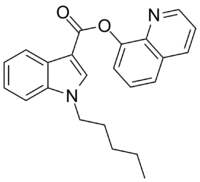PB-22
 | |
| Legal status | |
|---|---|
| Legal status |
|
| Identifiers | |
| |
JSmol) | |
| |
| |
PB-22 (QUPIC, SGT-21 or 1-pentyl-1H-indole-3-carboxylic acid 8-quinolinyl ester) is a
PB-22 has an EC50 of 5.1 nM for human CB1 receptors, and 37 nM for human CB2 receptors.[3] PB-22 produces bradycardia and hypothermia in rats at doses of 0.3–3 mg/kg, suggesting potent cannabinoid-like activity.[3] The magnitude and duration of hypothermia induced in rats by PB-22 was notably greater than JWH-018, AM-2201, UR-144, XLR-11, APICA, or STS-135, with a reduction of body temperature still observable six hours after dosing.[3] One clinical toxicology study found PB-22 to be the cause of seizures in a human and his dog.[4]
History
PB-22 was originally developed by New Zealand legal highs company Stargate International in 2012 as SGT-21, intended to be a structural hybrid of QMPSB and JWH-018.[5] However, no intellectual property protection was applied for and the compound quickly became subject to widespread grey-market sales outside the control of the inventors.
Detection
A forensic standard of PB-22 is available, and the compound has been posted on the Forendex website of potential drugs of abuse.[6]
Legal status
As of 9 May 2014, PB-22 is no longer legal in New Zealand.[7]
In January 2014, PB-22 was designated as a
In Ohio, PB-22 is illegal.[10]
Florida also has banned PB-22.[11]
Since 13 December 2014 it is also illegal in Germany because of adding the substance to the BtMG
As of October 2015 PB-22 is a controlled substance in China.[12]
See also
References
- S2CID 1279637.
- S2CID 235808519.
- ^ PMID 25921407.
- S2CID 207647659.
- PMID 32880103.
- ^ Forendex entry, Southern Association of Forensic Scientists
- ^ Jones N (1 May 2014). "Legal highs pulled from shelves". New Zealand Herald. New Zealand Media and Entertainment. Retrieved 18 August 2020.
- PMID 24876364.
- ^ "PB-22 and 5F-PB-22" (PDF). Drug Enforcement Administration, Office of Diversion Control.
- ^ Pelzer J (April 17, 2014). "Ohio bans two synthetic marijuana drugs sold as "herbal incense"". cleveland.com.
- ^ "Statutes & Constitution :View Statutes : Online Sunshine". Leg.state.fl.us. 1997-05-06. Retrieved 2014-07-12.
- ^ "关于印发《非药用类麻醉药品和精神药品列管办法》的通知" (in Chinese). China Food and Drug Administration. 27 September 2015. Archived from the original on 1 October 2015. Retrieved 1 October 2015.
